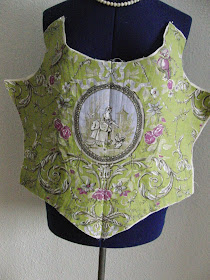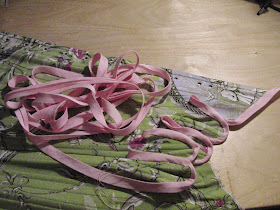CAUTION!
What fallows is a very long post again!
Ok, now I know for sure, that stays like mine are not done in two to three days. And not in four. At least not by me.
Maybe 6???
As you can imagine I've been working hard on the binding of my stays from Linda Baumgarten's "Costume Close-Up"...
My first step of the binding preparation was remembering an
article (on foundationsrevealed.com) I once read about stay and corset binding, so I searched for it to refresh my memory.
The tutorial is very good, but unfortunately not applicable on leather for all steps...
Since I didn't want to ruin my newborn stays I made a testpiece first. (I am getting used to test pieces...)
Have a look:
My testpiece has been a testpiece before... I used my pattern to cut two tabs exactly the size on my stays.
 |
| My testpiece |
Then I started sewing on a 2,5cm wide leather strip around the edge like described in the tutorial I mentioned above.
To test the look I used two different stitches for the test tabs: backstitch and running stitch
Then I folded the leather to the under-side and attached it to the lining, again using two different methods to compare.
On the left side I made small cuts and stretched the leather a lot to go smoothly around the tab.
On the right side I used bigger cuts, which made it easier to achieve the curvy shape.
Which one to choose?
I am going for the small cuts.
Easier is not always better... Sure the right side was easier, but I am a really careful person when it comes to things I have never done before. I am just too scared that the big cuts would make an ugly sight and also that the leather would snap.
So much for the outside curves.
Now the inside curves (again two methods):
To make an easy way around this needlepoint corner I made a cut at the centre of the curve. This was quite easy and neat, both inside and outside.
BUT, when I stretched the leather to lie flat on the backside the cut teared open even further... Not good.
For the second option I decided not to make any sharp cuts or anything that would invite the leather to make exactly the same as above. So I cut out the piece as shown in the picture below. The now narrower strip can be folded around the inner edge much easier (but not as easy as the big cut, sigh..) and minimizes the risk of damage to the leather.
Now the right-side picture you have been waiting for:
Left: Right:
Running stitch, big cuts, cut on the inner edge Backstitch, small cuts, section cut out on the inner edge
Right it is!!!
Since I am not tatally crazy I will start the comfortable (well, as comfartable as it can be) top-edge of my stays...
Tools to use:
big scissors (for the leather), small scissors (for the thread), pincer (is that the right word? - to pull the needle out of the mass of fabrics, tweezers (to pull my thread in delicate situations) and an ordinary handsewing needle. And thread.
NO LEATHER NEEDLE!!!
I made the experience, that a leather needle would indeed cut easily through leather of any kind, but due to its sharp triangle point it also gives the perfect start-up for a (very much feared) fissure.
So an ordinary needle it is:-)
 |
| My binding tools |
Let's do it!!!
 |
| My, er, binding to be |
My leather strips are 2,5cm wide as tested on my testpiece.
I used a rather small backstitch to sew the leather to the stays, making sure to have a relativly small seam allowance like the original stays.
 |
| Leather strip sewn to the stays, right sides together |
 |
| Phew, halway there... |
Silly me said: "The worst part is done! One only has to pull the leather back and attach it, right?"
WRONG!
The first small binding challenge arrived not even 10cm later, when I was faced with an edge. Folding the leather over the edge woul produce a bulk I wanted to avoid. Therefore I made a cut where the tutorial told me to fold.
Ah, le voilà!! Good edge!
Now it appeared that my former goat wasn't a big one, so my strip was not long enough to cover the entire top. I used a very narrow overcast stitch to sew two strips together and than continue the binding as if nothing happened...
Hurrah!!!! One edge down, one to go...
 | |
| Leather binding inside and outside. |
|
|
















































